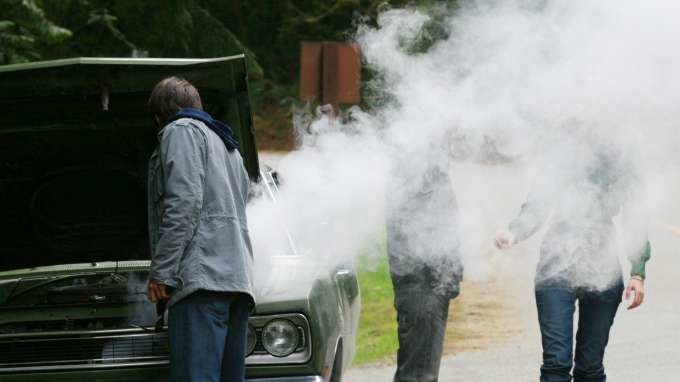Car radiator repairs are one of the more dramatic malfunctions that you may have to deal with as a driver. Because of the nature of the heat and pressure that’s contained within the cooling system, these types of problems are what we associate with the stereotypical cloud of steam coming from under a disabled car’s open hood. The radiator is obviously the most well known part of the cooling system, but it’s frequently not the culprit when it comes to a malfunction. Here are some of the most common repairs to a vehicle’s cooling system:
- A failed thermostat. The thermostat is the most common culprit when a vehicle overheats. The thermostat isn’t actually part of the radiator itself, but a type of valve that controls how much coolant can flow into and out of the radiator. This helps keep the engine at optimum operating temperature. When the thermostat fails, the car begins to overheat very quickly.
- Leaky radiator hoses. The most common source of a leak within the cooling system isn’t the radiator, but the radiator hoses. The hoses link the radiator to the engine and allow coolant to flow between the two. Radiator hoses are considered to be a wear component, which means that they should be replaced periodically, whether they are working well or not. That’s because they tend to become more prone to failure over time.
- Air in the cooling system. Air can become trapped in the cooling system, which restricts the flow of coolant and reduces its efficiency. If your car seems to be running hot, you might want to see about having the cooling system bled to remove possible air bubbles.
- Radiator leaks. Leaks in the radiator itself are harder to locate and repair than problems with hoses. Look for bubbles or steam coming from the radiator to signal the location of a leak. Leaky radiators can sometimes be patched, but it’s a tricky job.
- A failed water pump. The cooling system uses a pump to move the coolant throughout the engine in order to regulate the temperature. Water moves through the radiator, past the pump, into the engine and then is forced back into the radiator. If the water pump fails, the water no longer circulates properly and the car will overheat. A broken water pump is fairly common.
- Cooling system obstructions. Obstructions can take the shape of engine “scale” blocking the cooling passages in the engine or radiator, which makes it difficult for coolant to move efficiently. Obstructions can also happen when something restricts the flow of air through the radiator, which in turn makes it hard for the radiator to transfer heat to the air. This can be caused by anything from bent fins to body damage from an accident.
- A failed radiator fan. Modern cars use an electric fan to pull enough air through the radiator to keep the car cool at idle and low speeds. A car that does fine on the freeway but overheats at idle or in traffic probably has a problem with the radiator fan.
How a Car Radiator Works
The main function of the radiator is to dissipate the excess heat generated by the car’s engine as it burns fuel. It functions as a component of the larger cooling system. As engine coolant moves through the radiator, it goes through a few simple processes.
Intake
The engine’s water pump produces a flow of coolant that runs in a specific direction into and out of the radiator. The amount of coolant that moves through the radiator is controlled by the thermostat, which opens and closes according to the temperature of the engine. Once the flow of engine coolant moves past the thermostat, it enters the radiator through the upper hose. There are two basic types of radiators: downflow and crossflow. On a downflow radiator, the coolant enters an upper tank and moves down across the body of the radiator. On a crossflow radiator, the coolant enters a side tank (usually on the driver’s side of the car) and flows sideways toward the other side of the radiator. Many modern cars use the crossflow design because it allows the radiator to have a shorter vertical dimension which helps with hood clearance.
Cooling
Once the coolant enters the first tank, it flows into tiny passages that connect the two tanks. These small passages are connected to rows of fine metal fins, which are what give the radiator its distinct ribbed appearance. The metal fins are usually made of either copper or aluminum. These two metals are used because they are very efficient at conducting and transferring heat. As the coolant moves through the smaller tubes, the excess heat is transferred into the metal fins. Air is forced through the spaces in between these fins (either by the motion of your car, or by your car’s engine cooling fan) and the heat is dispersed away from the engine in the form of hot air. This process keeps heat from building up in your engine, preventing overheating.
Outlet
Once the engine coolant has moved through the cooling passages, it is collected in another tank on the other side of the radiator which stores the coolant until it is taken into the outlet hose. The radiator’s outlet hose connects the radiator to the water pump and it supplies the low-temperature coolant to the engine as needed. The outlet hose is subjected to suction force from the water pump, so it is usually re-enforced with a spring that keeps it from collapsing and blocking the flow of coolant.
These are the three basic processes of your radiator. It’s easy to see how important your car’s radiator is to the proper functioning of the engine, and why it’s important to follow proper maintenance guidelines to keep the cooling system in good working condition.

